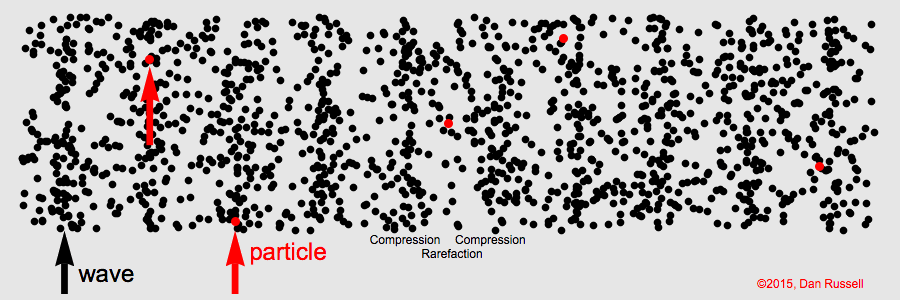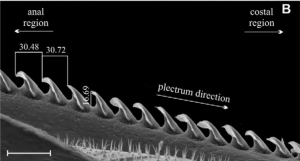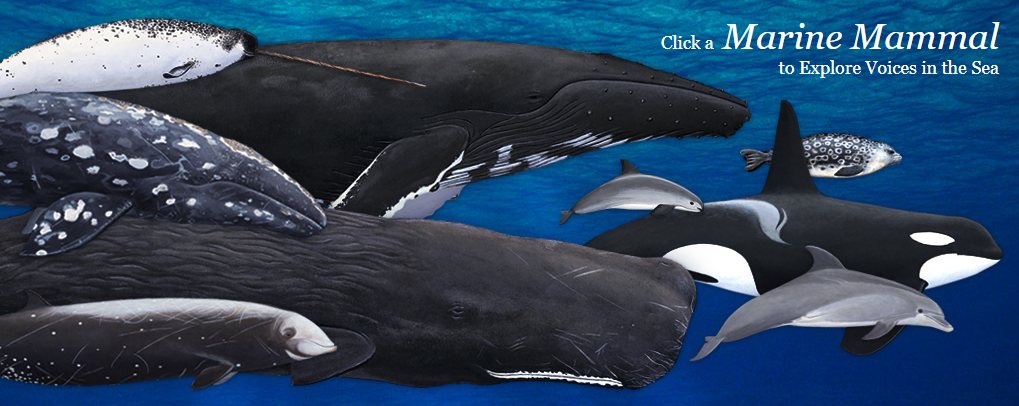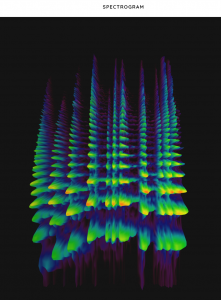For kids from ages 5 to 92…
Dolphins, whales, seals and sea lions, oh-my!
Visit this interactive museum exhibit designed by our friends at The Scripps Institution of Oceanography Whale Acoustics Lab. You can hear the sounds produced by many of the animals that we study in MAR lab as well as play games and watch short videos about the various ways we study these animals.
How do animals produce sound?
Many animals, including us, squeeze their lungs to force air up their throat and out of their mouths. The air particles bounce against one another, a bit like a bumper cars. One particle bounces into another, it rebounds and hits another, and so on. We can see how this works below. Pay close attention to the particles marked in red. They go back and forth as they hit other particles. Even though each particle just moves back and forth, it looks like the particles are traveling across the screen. You hear when the last set of particles hit your ear.

Areas where there are lots of particles have high pressure and we see “waves” of high pressure regions. The more closely spaced the waves are, the higher we hear the pitch.
Not all animals squeeze air out of their lungs. Dolphins for example, cannot breathe underwater and have a system near their blow hole that moves air around that area and across their sound producing “monkey lips,” the dolphin equivalent of your vocal folds (voice box).
Some animals do not use air in their bodies at all to produce sound. Many insects rub two body parts together to create sounds. As an example, crickets have a saw-like structure on the bottom of their upper wings called a file. On the top of the lower wing, a scraper called the plectrum sticks out. When they rub the wings across each other, it produces sound, much like if you run your fingernail across a comb.

File on a cricket wing (Montealegre 2008 J Exp Biol)
You can see a video of a cricket doing this at full speed and then slowed down here:
How do we use sound in our lab?
The MAR lab designs programs that use sound to learn about when and where animals are present, what kind of animals are there, and what they are doing. Knowing things about when animals are in certain spots lets humans consider how we might want to change our behavior if we are interested in protecting the environment.
How we do this requires a lot of information that you might choose to learn in college. Here are some of the basics of how we do this without going too deep into the details.
Visualizing sound
Microphones (called hydrophones when they are underwater) record pressure that comes from the air particles being tightly or loosely packed. When you have a slightly blown up balloon, the pressure is low and the balloon is squishy. When you inflate the balloon all the way, pressure is high and it is much harder to squish the balloon without it popping. Unfortunately, microphone measurements are hard for humans to understand. So we use a very old method created by the French mathematician Jean-Baptiste Fourier in the 1800s to transform the pressure measurements into measurements of which pitches are loud or quiet. When we do this many times on short sound segments, we can make a picture that lets us better see what is going on.
This is the first step in many sound processing methods and is called a spectrogram. You can create spectrograms of your own voice by clicking on the image below.
Using machine learning to process sounds
Once we have a good representation of sound such as the spectrogram, we need to decide things about the sounds that were recorded. For example, can we figure out from the sounds an animal is making whether or not it is looking for food? If we can identify a sound associated with looking for food, then we can write a program that learns to look for that sound in recordings.
Understanding how we write programs to make decisions requires many concepts that you might not have studied yet, but do not worry. Everything is learned one step at a time and we will try to give you some ideas about how this is done without getting too technical.
We write machine learning programs to make decisions in two main categories. One type is for when we can provide the program with examples of things for which we know the right answer. For example, I might have examples of whistles from two dolphin species. From these examples, the machine learns how to make such decisions on its own.
Learning is the process of determining what decision should be made. One popular type of learning is to try to find boundaries between different types of things. Imagine that you are playing the 20 questions game. If the person you are playing with is thinking of a dog breed, you might ask if it is a big dog. This divides dogs into big and small dogs. Each time you ask a question, you further divide the possibilities. We would want a computer learner to figure out from examples what questions should be asked.
A popular learning method that follows this approach of learning boundaries is a neural net, which loosely imitates what the cells in our brain do, but our brains are much more powerful. You can play with a toy neural net. It is a bit complicated, but if you are visiting our lab during an open house, please ask us and we will be happy to describe what is going on. If you just want to see a neural net in action, you can draw numbers and see what the machine predicts you drew.
The second type of learning is a grouping problem. If we do not know what to call things, can we have the computer find categories for us? We typically look for a measurement of how similar things are and then group similar things together. A very popular way to do this is called k-means, and Mr. Nitoyon has developed a nice way to see how this works.

